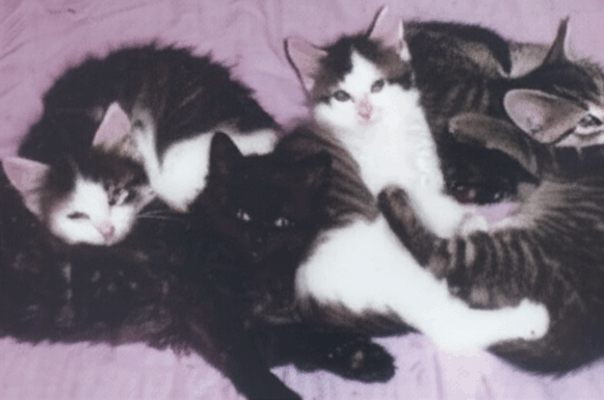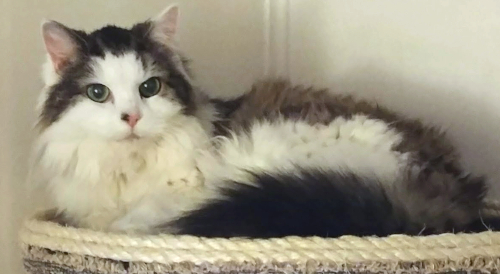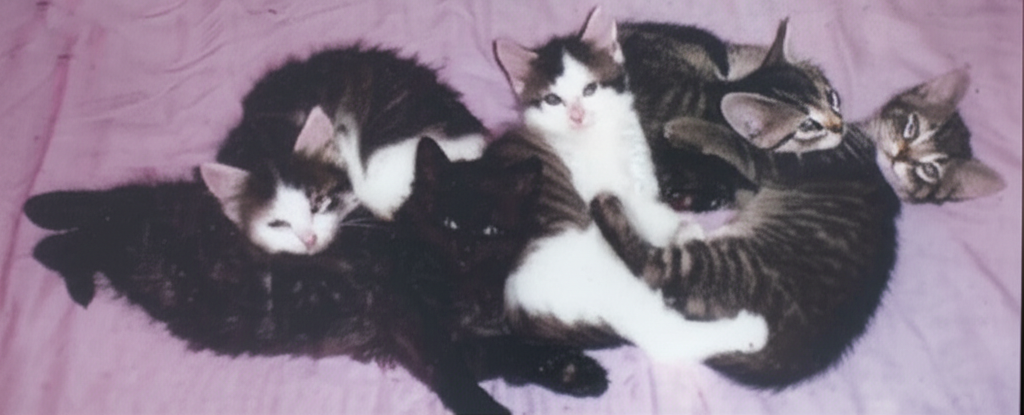Here on the blog, you often hear about Belle and Paws, our two current rescue cats who bring so much joy (and a little bit of chaos!) to our lives. But behind every rescue story, there are others that paved the way, lessons learned, and hearts touched. Today, I want to share the story of Bubbles, a cat who quite literally showed up on our doorstep and unexpectedly changed our lives forever.
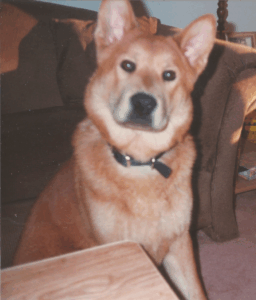 We lived in a different home back then, and our loyal dog, Buddy, was a fixture in our daily routine. During his potty breaks, a curious visitor started to appear. We affectionately nicknamed her “Kitty” – a sleek cat with an air of independence. She was undeniably friendly, always eager for a head scratch and a purr that rumbled like a tiny engine. However, she was a feral through and through. Buddy, bless his oblivious heart, would sometimes get a little too enthusiastic in his greetings, resulting in a swift, well-aimed swat from Kitty to remind him of personal space. Any attempt to scoop her up in our arms was met with the same prickly resistance, followed by a quick retreat to the perceived safety of the outdoors.
We lived in a different home back then, and our loyal dog, Buddy, was a fixture in our daily routine. During his potty breaks, a curious visitor started to appear. We affectionately nicknamed her “Kitty” – a sleek cat with an air of independence. She was undeniably friendly, always eager for a head scratch and a purr that rumbled like a tiny engine. However, she was a feral through and through. Buddy, bless his oblivious heart, would sometimes get a little too enthusiastic in his greetings, resulting in a swift, well-aimed swat from Kitty to remind him of personal space. Any attempt to scoop her up in our arms was met with the same prickly resistance, followed by a quick retreat to the perceived safety of the outdoors.
Despite her reluctance to be handled, we grew fond of her visits. Eventually, we started leaving out a small dish of food for her. She’d cautiously approach, eat her fill, and then linger a little longer, her initial apprehension slowly melting away with each shared moment. We respected her boundaries, understanding that trust takes time, especially with a cat accustomed to fending for herself.
We noticed a Shift in Bubbles
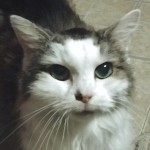 Then came the day that everything shifted. Bubbles (the name she eventually earned, a softer moniker for a cat who was about to bring so much gentleness into our lives) arrived, and she was… different. The usual skittishness was gone, replaced by an almost desperate need for affection. She rubbed against our legs incessantly, her purr a constant vibration. It didn’t take long to realize the reason for this sudden change: Bubbles was heavily pregnant.
Then came the day that everything shifted. Bubbles (the name she eventually earned, a softer moniker for a cat who was about to bring so much gentleness into our lives) arrived, and she was… different. The usual skittishness was gone, replaced by an almost desperate need for affection. She rubbed against our legs incessantly, her purr a constant vibration. It didn’t take long to realize the reason for this sudden change: Bubbles was heavily pregnant.
Our hearts ached for her. The thought of her trying to navigate the harsh realities of outdoor life while carrying a litter of kittens was unbearable. We knew we had to try and help. With gentle coaxing and a lot of patience, we managed to guide her into the house. It wasn’t easy; ingrained instincts are powerful. But the lure of warmth, safety, and perhaps a primal understanding that she needed protection for her unborn babies, finally won out.
Bringing a feral cat indoors, especially one who is pregnant, requires careful consideration and a prepared environment. We were fortunate that Bubbles took to the litter box almost immediately, a huge relief as this isn’t always the case with feral cats transitioning indoors. However, knowing what to expect is crucial for anyone considering taking in a pregnant stray or feral cat.
Creating a Safe Haven for a Pregnant Cat
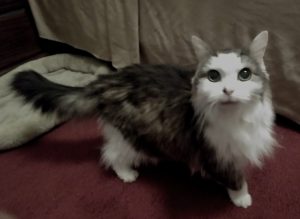 If you find yourself in a similar situation, here are some essential steps to create a stress-free and secure environment for a pregnant cat:
If you find yourself in a similar situation, here are some essential steps to create a stress-free and secure environment for a pregnant cat:
- A Quiet Sanctuary: The most important thing is to provide a calm, secluded space where the cat feels safe and undisturbed. This could be a spare room, a quiet corner of a room, or even a large closet. Avoid high-traffic areas and loud noises.
- The Nesting Box: Observe where the cat seems to feel most comfortable. In our case, Bubbles instinctively chose the space under the vanity in our bedroom. Recognizing this, we placed a cardboard box lined with soft blankets there. The box should be large enough for the mother to comfortably move around and nurse her kittens, with sides high enough to keep the newborns contained. Make sure the entrance is low enough for her to easily get in and out.
- Comfort and Cleanliness: Provide soft, washable blankets or towels inside the nesting box. Be prepared to change these regularly to maintain a clean and hygienic environment, especially after the kittens arrive.
- Easy Access to Essentials: Place food and water bowls close to the nesting area so the mother doesn’t have to travel far, especially in the later stages of pregnancy and the early days of nursing. Opt for high-quality kitten or all-life-stages food to provide the necessary nutrients.
- Litter Box Proximity: Ensure a litter box is readily accessible, but not too close to the food and water. A pregnant cat may need to use the litter box more frequently.
Observe and Be Patient: Allow the cat to settle in and adjust at her own pace. Avoid overwhelming her with too much attention initially. Let her know you are there for support, but respect her need for space and security. - Veterinary Care is Crucial: As soon as possible, take the pregnant cat to a veterinarian for a check-up. They can confirm the pregnancy, estimate the due date, and provide guidance on prenatal care and what to expect during labor and delivery.
Bubbles quickly made herself at home in her cozy box under the vanity. It became her safe haven, the place where she would eventually bring her tiny miracles into the world. We watched from a respectful distance as she gave birth to a healthy litter of five kittens: Precious, Zippy, Rascal, Blackie, and Skittles.
The arrival of the kittens brought a whole new level of responsibility. Suddenly, we weren’t just caring for one formerly feral cat; we were caring for a brand-new family.
Caring for a Mother Cat and Her Kittens
The first few weeks are crucial for the kittens’ development and the mother-kitten bond. Here’s what we learned:
- Maintaining a Clean Nest: We regularly changed the blankets in the nesting box to prevent the buildup of bacteria and ensure a clean environment for the vulnerable newborns.
Nutritional Support for Mom: Bubbles needed constant access to high-quality food to produce enough milk for her growing kittens. We made sure her food and water bowls were always full. - Observing Kitten Health: We kept a close eye on the kittens, ensuring they were nursing regularly, gaining weight, and active during their awake periods. Any signs of lethargy or distress would have warranted an immediate vet visit.
- Gentle Socialization: As the kittens grew, we gently handled them for short periods to acclimate them to human touch. However, we always allowed Bubbles to be present and lead the interactions, ensuring she felt secure.
- Introducing Solid Food and Litter Training: Around four weeks of age, we started introducing the kittens to a shallow dish of wet kitten food. By six to eight weeks, they were also nibbling on dry kitten food. We also introduced them to a small, easily accessible litter box, often placing them in it after meals. Bubbles, being the excellent mother she was, also played a role in their litter box training.
What was truly remarkable about Bubbles’ story was her complete transformation. This cat, who once fiercely guarded her outdoor independence, never tried to leave our home again after her kittens were born. The instinct to protect her young seemed to override her feral tendencies. In fact, even the act of carrying her to the door to look outside would elicit such distress that she would fight her way out of our arms to run and hide inside. She had found her safe haven, and she wasn’t letting go.
Soothing Comfort: The Magic of Warm and Cold Compresses for a Nursing Mom
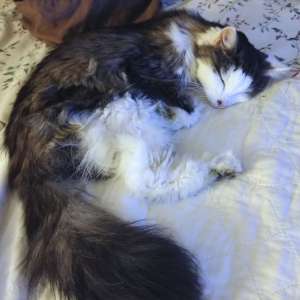 Beyond the basics of food, water, and a clean nest, we discovered a little ritual that seemed to bring Bubbles immense comfort during her time nursing her kittens: warm and cold compresses for her nipples. As any new mother, human or feline, can attest, breastfeeding can sometimes lead to discomfort, engorgement, or even mild inflammation. We noticed Bubbles occasionally seemed a little tender, and after doing some research (and a bit of cautious trial and error), we found a way to provide her with some much-needed relief.
Beyond the basics of food, water, and a clean nest, we discovered a little ritual that seemed to bring Bubbles immense comfort during her time nursing her kittens: warm and cold compresses for her nipples. As any new mother, human or feline, can attest, breastfeeding can sometimes lead to discomfort, engorgement, or even mild inflammation. We noticed Bubbles occasionally seemed a little tender, and after doing some research (and a bit of cautious trial and error), we found a way to provide her with some much-needed relief.
We started with gentle warm compresses. Using a soft cloth soaked in warm (but not hot!) water, we would gently apply it to her nipples for a few minutes. The warmth seemed to soothe any tenderness and encourage healthy milk flow. What was truly heartwarming was how quickly Bubbles came to associate this with comfort. Soon, whenever we would say, “Time for a compress?” she would actually roll onto her belly, purring contentedly and presenting herself for the treatment. It was as if she understood that this simple act would bring her relief.
Later in the nursing period, we also incorporated cool compresses. These helped to reduce any potential swelling or discomfort after the kittens had finished nursing. Again, Bubbles was incredibly cooperative, often nuzzling into the cool cloth with a sigh of contentment.
The Importance of Gentle Care for a Nursing Mother
Providing this kind of gentle care for a nursing mother cat is more than just a sweet gesture; it can play a vital role in her well-being and her ability to care for her kittens.
- Relieving Engorgement: In the early days of nursing, a mother cat’s milk supply can sometimes exceed the kittens’ needs, leading to engorgement, which can be uncomfortable and even painful. Warm compresses can help stimulate milk flow and relieve this pressure.
- Soothing Tenderness: The constant nursing of multiple kittens can sometimes make a mother cat’s nipples sore or tender. Warm compresses can provide soothing relief.
Reducing Inflammation: In some cases, mild inflammation can occur. Cool compresses can help to reduce swelling and discomfort.
Strengthening the Bond: These gentle interactions can also strengthen the bond between you and the mother cat, showing her that you are there to provide comfort and support.
Important Considerations: - Always be gentle: Never apply hot or very cold compresses, as this could cause discomfort or even injury. The temperature should be comfortably warm or cool to the touch.
Observe her reaction: Pay close attention to the mother cat’s body language. If she seems uncomfortable or resists the compresses, stop immediately.
Maintain hygiene: Always use clean cloths for each application. - Consult your veterinarian: If you notice any signs of significant inflammation, pain, or infection in the mother cat’s nipples, it’s crucial to consult your veterinarian. Compresses can provide comfort, but they are not a substitute for professional medical care when needed.
Our little “compress time” with Bubbles became a special part of our routine, a quiet moment of connection and care. It was a beautiful reminder that even the smallest acts of comfort can make a world of difference to a new mother, whether they have two legs or four. It also reinforced the incredible trust Bubbles placed in us, a far cry from the wary feral cat who once kept her distance. This simple act of care truly underscored the depth of the bond we had formed with this extraordinary cat.
Finding a Home (or not)
While our initial intention was to find good homes for the kittens, life, as it often does, had other plans. We found a wonderful home for Precious, and we were heartbroken but happy to see her thrive for many years (we eventually lost touch with her owner after several years because they moved). However, the remaining kittens – Zippy, Rascal, Blackie, and Skittles – became permanent members of our family, alongside their devoted mother, Bubbles.
Bubbles, the once-feral cat, became the matriarch of our little indoor cat clan. None of them ever ventured outside. It was a fascinating dynamic – a feral mother raising a litter of strictly indoor cats. She taught them the ways of feline life within the confines of our home, from the importance of a good nap in a sunbeam to the proper technique for chasing a dust bunny.
Caring for a family of six cats (eventually five as Bubbles aged and passed) was a significant commitment. It meant multiple litter boxes to scoop daily, a constant supply of food and water, regular veterinary check-ups, and a lot of love and attention to go around. It also meant accepting the individual personalities of each cat, from Zippy’s playful antics to Blackie’s quiet cuddles.
Bubbles’ story is a testament to the resilience of animals and the unexpected ways they can find their forever homes. It’s also a reminder that taking in any animal, especially one with a challenging past or unique needs like a pregnant feral cat, is a significant responsibility. It requires patience, understanding, and a willingness to adapt.
While Bubbles and her kittens are no longer with us, their memory lives on and their story continues to inform how we approach rescue and care for our current feline companions. Bubbles taught us so much about trust, the power of a mother’s love, and the unexpected joys that can come from opening your heart and home to those who need it most. And yes, she also taught us a lot about the importance of having enough litter boxes!


